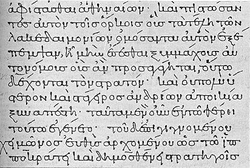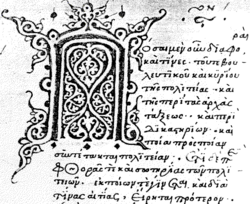
Minuscule Greek
Encyclopedia


Greek alphabet
The Greek alphabet is the script that has been used to write the Greek language since at least 730 BC . The alphabet in its classical and modern form consists of 24 letters ordered in sequence from alpha to omega...
writing which was used as a book hand in Byzantine
Byzantine Empire
The Byzantine Empire was the Eastern Roman Empire during the periods of Late Antiquity and the Middle Ages, centred on the capital of Constantinople. Known simply as the Roman Empire or Romania to its inhabitants and neighbours, the Empire was the direct continuation of the Ancient Roman State...
manuscripts since the 9th and 10th centuries. It replaced the earlier style of uncial writing, from which it differed in using smaller, more rounded and more connected letter forms, and in using a large number of ligatures
Greek ligatures
Greek ligatures are graphic combinations of the letters of the Greek alphabet that were used in medieval handwritten Greek and in early printing. Ligatures were used in the cursive writing style and very extensively in later minuscule writing. There were many dozens of conventional ligatures...
. Many of these forms had previously developed as parts of more informal cursive
Cursive
Cursive, also known as joined-up writing, joint writing, or running writing, is any style of handwriting in which the symbols of the language are written in a simplified and/or flowing manner, generally for the purpose of making writing easier or faster...
writing. The basic letter shapes used in the minuscule script were the ancestors of modern lower case Greek letters.
From the 10th century onwards, most Byzantine manuscripts of classical and early Christian Greek works were gradually rewritten in the new minuscule style, and few of the older uncial manuscripts were preserved. For this reason, uncial manuscripts are today extremely rare, while early minuscule manuscripts are often the oldest preserved sources attesting an ancient work and may therefore be of central importance for its philological
Philology
Philology is the study of language in written historical sources; it is a combination of literary studies, history and linguistics.Classical philology is the philology of Greek and Classical Latin...
study. Manuscripts from the oldest phase of minuscule writing (mid-9th to mid-10th century) are known in scholarship today as codices vetustissimi ("oldest codices"). Those from the mid-10th to the mid-12th centuries are known as codices vetusti ("old codices"), and later ones as codices recentiores ("newer codices").
Minuscule writing remained in use for handwriting throughout the Byzantine and into the post-Byzantine era. In the modern era, western printers used minuscule book hands as a model for developing early Greek print fonts. Like with Latin, it became common to mix minuscule writing with some uncial or capital letters, with the latter used for emphasis, in titles and initials. From this practice, the modern orthographic system of letter case
Letter case
In orthography and typography, letter case is the distinction between the larger majuscule and smaller minuscule letters...
for Greek arose. In modern Greek writing, the upper case letters are generally modeled on the letter shapes of ancient inscriptions, while the lower case letters are based on the tradition of minuscule handwriting.
| Majuscule | Uncial | Cursive | Minuscule | Minuscule with ligatures | Modern lower case |
|---|---|---|---|---|---|
| Α Alpha (letter) Alpha is the first letter of the Greek alphabet. In the system of Greek numerals it has a value of 1. It was derived from the Phoenician letter Aleph... |
α | ||||
| Β Beta (letter) Beta is the second letter of the Greek alphabet. In Ancient Greek, beta represented the voiced bilabial plosive . In Modern Greek, it represents the voiced labiodental fricative .... |
β | ||||
| Γ | γ | ||||
| Δ Delta (letter) Delta is the fourth letter of the Greek alphabet. In the system of Greek numerals it has a value of 4. It was derived from the Phoenician letter Dalet... |
δ | ||||
| Ε | ε | ||||
| Ζ Zeta (letter) Zeta is the sixth letter of the Greek alphabet. In the system of Greek numerals, it has a value of 7. It was derived from the Phoenician letter Zayin... |
ζ | ||||
| Η Eta (letter) Eta ) is the seventh letter of the Greek alphabet. Originally denoting a consonant /h/, its sound value in the classical Attic dialect of Ancient Greek was a long vowel , raised to in medieval Greek, a process known as itacism.In the system of Greek numerals it has a value of 8... |
η | ||||
| Θ | θ | ||||
| Ι | ι | ||||
| Κ | κ | ||||
| Λ | λ | ||||
| Μ Mu (letter) Carlos Alberto Vives Restrepo is a Grammy Award and three-time Latin Grammy Award winning-Colombian singer, composer and actor.-Biography:... |
μ | ||||
| Ν Nu (letter) Nu , is the 13th letter of the Greek alphabet. In the system of Greek numerals it has a value of 50... |
ν | ||||
| Ξ | ξ | ||||
| Ο | ο | ||||
| Π Pi (letter) Pi is the sixteenth letter of the Greek alphabet, representing . In the system of Greek numerals it has a value of 80. Letters that arose from pi include Cyrillic Pe , Coptic pi , and Gothic pairthra .The upper-case letter Π is used as a symbol for:... |
π | ||||
| Ρ Rho (letter) Rho is the 17th letter of the Greek alphabet. In the system of Greek numerals, it has a value of 100. It is derived from Semitic resh "head"... |
ρ | ||||
| Σ | σ | ||||
| Τ | τ | ||||
| Υ | υ | ||||
| Φ Phi (letter) Phi , pronounced or sometimes in English, and in modern Greek, is the 21st letter of the Greek alphabet. In modern Greek, it represents , a voiceless labiodental fricative. In Ancient Greek it represented , an aspirated voiceless bilabial plosive... |
φ | ||||
| Χ Chi (letter) Chi is the 22nd letter of the Greek alphabet, pronounced as in English.-Greek:-Ancient Greek:Its value in Ancient Greek was an aspirated velar stop .-Koine Greek:... |
χ | ||||
| Ψ Psi (letter) Psi is the 23rd letter of the Greek alphabet and has a numeric value of 700. In both Classical and Modern Greek, the letter indicates the combination /ps/ . The letter was adopted into the Old Italic alphabet, and its shape is continued into the Algiz rune of the Elder Futhark... |
ψ | ||||
| Ω | ω | ||||

